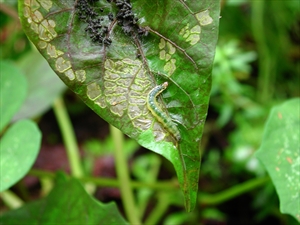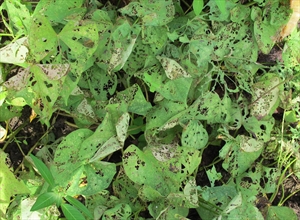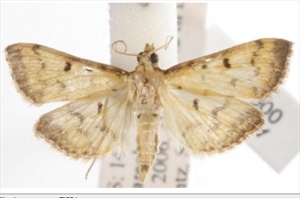Sweetpotato leaf folder, green leaf folder
Pacific Pests, Pathogens and Weeds - Online edition
Pacific Pests, Pathogens & Weeds
Sweetpotato leaf folder (028)
Psara hipponalis; previously, Herpetogramma hipponalis. It is a moth of the Crambidae.
Common throughout Asia and Africa. It is recorded from Solomon Islands.
Sweetpotato (Ipomoea batatas) is a major host. The caterpillars also occur on other Ipomoea species and Mikania cordata.
The caterpillar does the damage. It folds the leaf, holding the folded parts together with webbing. The young caterpillars eat the surface of the leaf (Photo 1); later, when larger, they eat through the leaf creating small windows and holes (Photo 2).
The moth lays eggs singly or in groups on the upper surface of the leaf near the midrib. About 90 eggs are laid in a day. The eggs are shiny green, oblong, and covered with a scale-like gelatinous material. The eggs hatch after 3-5 days, and the caterpillars are at first greenish-yellow, turning darker green with age. They have a dark brown head. The caterpillars moult four times over 15-30 days and when mature are about 13 mm long. Only the larger caterpillars fold the leaves. In most cases, there is one caterpillar per leaf fold.
The caterpillars turn into yellowish-white pupae, which later become reddish brown. The adults emerge from the pupae in 4-8 days; they are yellowish-brown with dark brown zigzag markings on the wings (Photo 3). The female moth lives for about 3 days.
Often, the damage looks severe with all the youngest leaves folded (Photo 2), and they may turn brown, but there is no information on the effect of leaf damage on storage root yield. Pruning experiments have shown that sweetpotato can lose up to a third of their leaves without impacting on yield., but more studies are needed to confirm this, and relate time of defoliation with storage root yield.
Look for leaves folded and held together with webbing; unfold the leaves and look for caterpillars and faecal pellets ('droppings'). Look at the surface of the leaf for small windows between the veins caused by the caterpillar eating the upper surface of the leaf. The adult moth is brown with zigzag markings on the wings.
NATURAL ENEMIES
Braconid wasps are common and control the leaf folder populations. Brachymeria sp. as chalcid wasp is reported from the Philippines. They are seen rarely as they are so small. Earwigs and other predators are also important in maintaining natural control.
CULTURAL CONTROL
Before planting:
- The use of uninfested planting material is an effective means of reducing the incidence of leaf folders. Carefully choose cuttings for replanting; remove folded leaves or choose only those cuttings free of them.
- If possible, do not plant new gardens next to those that have high infestations of leaf folder, otherwise the moths will easily spread to the new gardens.
During growth:
- Where populations are relatively low, look for eggs masses on the leaves and destroy them. If practical, remove folded leaves with larvae (caterpillars) and destroy.
After harvest:
- Collect the vines and other debris and burn them, especially if caterpillars from an outbreak still remain on the vines
CHEMICAL CONTROL
The leaf folder is usually under natural control by its enemies. Pesticides are not recommended as they disrupt the action of the egg and larval parasites, and make matters worse. Also, there is no evidence that the leaf folder reduces storage root yields. However, if infestations become severe, and pesticides are thought to be needed, do the following:
- Use plant-derived products (with the addition of soap), such as neem (see Fact Sheet no. 402), derris, pyrethrum and chilli (see Fact Sheet no. 504), or synthetic products that contain disease-causing organisms, such as spinosad (Success) and Bt - Bacillus thuringiensis var. kurstaki).
- Note, a variety of Derris, brought many years ago to Solomon Islands from Papua New Guinea, is effective as a spray. It contains rotenone, an insecticide, so it should be used with caution. There may be varieties of Derris (fish poisons) in your country that can be tried (see Fact Sheet no. 56).
- Synthetic pyrethroids are likely to be effective, but will also kill natural enemies.
____________________
When using a pesticide, always wear protective clothing and follow the instructions on the product label, such as dosage, timing of application, and pre-harvest interval. Recommendations will vary with the crop and system of cultivation. Expert advice on the most appropriate pesticide to use should always be sought from local agricultural authorities.
AUTHORS Helen Tsatsia & Grahame Jackson
Information from O'Sullivan J et al. (undated) Sweetpotato DiagNotes: A diagnostic key and information tool for sweetpotato problems. (https://keys.lucidcentral.org/keys/sweetpotato/key/Sweetpotato%20Diagnotes/Media/Html/FrontPage/FrontPage.htm); and from Amalin DM, Vasquez EA (1993) A handbook on Philippines sweet potato arthropod pests and the natural enemies. International Potato Center, Los Banos, Laguna, Philippines. (http://www.sweetpotatoknowledge.org/wp-content/uploads/2016/02/A-handbook-on-Philiphine-Sweetpotato-Anthropod-Pests-and-their-Natural-Enemies.pdf). Photo 3 Paul Hebert, BIO/CSIRO, Biodiversity Institute of Ontario.
Produced with support from the Australian Centre for International Agricultural Research under project PC/2010/090: Strengthening integrated crop management research in the Pacific Islands in support of sustainable intensification of high-value crop production, implemented by the University of Queensland and the Secretariat of the Pacific Community.






